Search Result
Results for "
fluorescein-isothiocyanate
" in MedChemExpress (MCE) Product Catalog:
| Cat. No. |
Product Name |
Target |
Research Areas |
Chemical Structure |
-
- HY-15941
-
|
fluorescein 5(6)-isothiocyanate; fluorescein isothiocyanate 5- and 6- isomers
|
Fluorescent Dye
|
Others
|
|
5(6)-FITC (Fluorescein 5(6)-isothiocyanate) is an amine-reactive derivative of fluorescein dye that has wide-ranging applications as a label for antibodies and other probes, for use in fluorescence microscopy, flow cytometry and immunofluorescence-based assays such as Western blotting and ELISA.
|
-
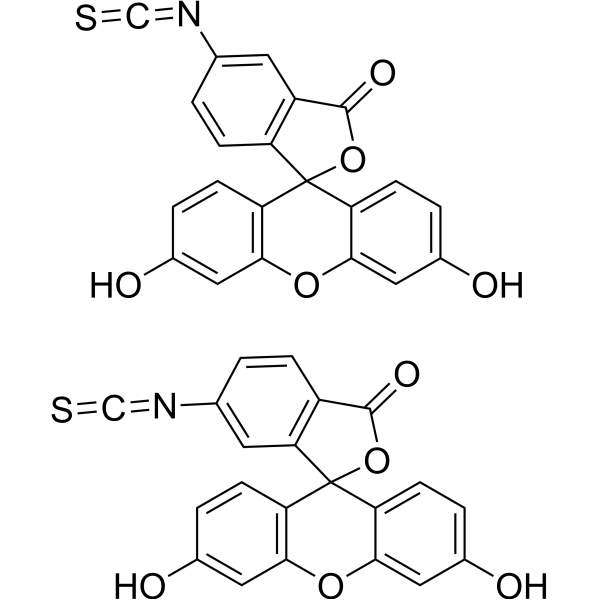
-
- HY-66020
-
6-FITC
1 Publications Verification
6-fluorescein isothiocyanate
|
Fluorescent Dye
|
Cancer
|
|
6-FITC (6-Fluorescein Isothiocyanate) is a derivative of fluorescein used in wide-ranging applications including flow cytometry.
|
-
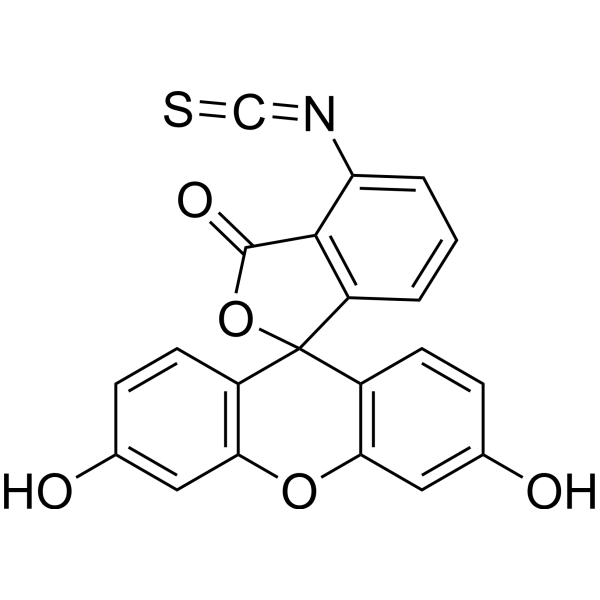
-
- HY-128868
-
|
|
Fluorescent Dye
|
Others
|
|
FITC-Dextran (MW 10000) is a fluorescent probe for fluorescein isothiocyanate (FITC) dextran (Ex=495 nm; Em=525 nm). FITC-Dextran (MW 10000) can be used as a marker to reveal heat shock-induced cell damage and to study the early and late stages of apoptosis. FITC-Dextran (MW 10000) can also be used for cell permeability studies, such as blood-brain barrier permeability and determination of the extent of blood-brain barrier disruption .
|
-

-
- HY-128868A
-
|
|
Fluorescent Dye
|
Others
|
|
FITC-Dextran (MW 4000) is a fluorescent probe for fluorescein isothiocyanate (FITC) dextran (Ex=495 nm; Em=525 nm). FITC-Dextran (MW 4000) can be used as a marker to reveal heat shock-induced cell damage and to study the early and late stages of apoptosis. FITC-Dextran (MW 4000) can also be used for cell permeability studies, such as blood-brain barrier permeability and determination of the extent of blood-brain barrier disruption .
|
-

-
- HY-128868D
-
|
|
Fluorescent Dye
|
Others
|
|
FITC-Dextran (MW 40000) is a fluorescent probe for fluorescein isothiocyanate (FITC) dextran (Ex=495 nm; Em=525 nm). FITC-Dextran (MW 40000) can be used as a marker to reveal heat shock-induced cell damage and to study the early and late stages of apoptosis. FITC-Dextran (MW 40000) can also be used for cell permeability studies, such as blood-brain barrier permeability and determination of the extent of blood-brain barrier disruption .
|
-

-
- HY-128868G
-
|
|
Fluorescent Dye
|
Others
|
|
FITC-Dextran (MW 150000) is a fluorescent probe for fluorescein isothiocyanate (FITC) dextran (Ex=491 nm; Em=518 nm). FITC-Dextran (MW 150000) can be used as a marker to reveal heat shock-induced cell damage and to study the early and late stages of apoptosis. FITC-Dextran (MW 150000) can be used in perfusion studies in animals or in fluorescence microlymphography, to study processes that affect the permeability of the blood brain barrier (BBB) . FITC-Dextran (MW 150000) can be used as fluorescent probe to study cell permeability .
|
-

-
- HY-D0108
-
|
|
Fluorescent Dye
|
|
|
Fluorescein dilaurate is a colorimetric probe formed by the reaction of adipic acid dihydrazide and fluorescein isothiocyanate.
|
-
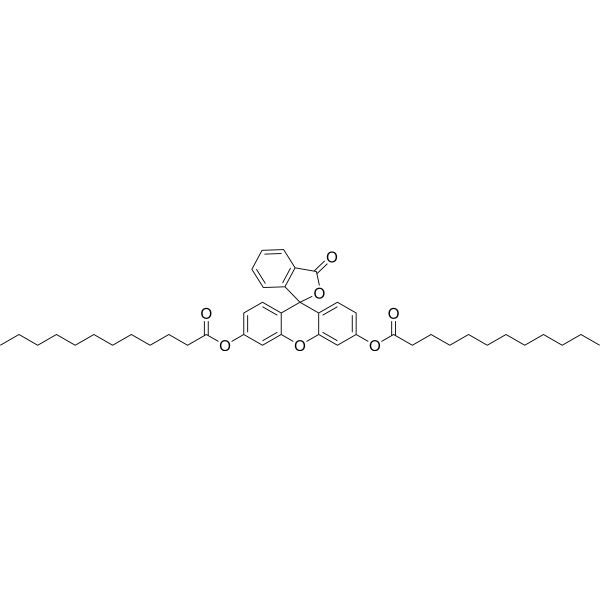
-
- HY-D0107
-
|
|
Fluorescent Dye
|
|
|
Fluorescein dicaproate is a colorimetric probe formed by the reaction of adipic acid dihydrazide and fluorescein isothiocyanate.
|
-

-
- HY-D0101
-
|
|
Fluorescent Dye
|
|
|
Fluorescein-diphosphat (diammonium) is a colorimetric probe formed by the reaction of adipic acid dihydrazide and fluorescein isothiocyanate.
|
-
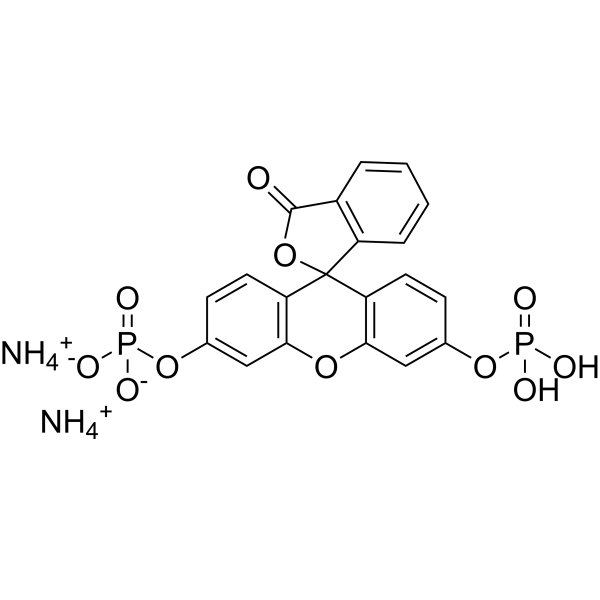
-
- HY-D0105
-
|
|
Fluorescent Dye
|
|
|
Fluorescein diacetate 6-isothiocyanate is a colorimetric probe formed by the reaction of adipic acid dihydrazide and fluorescein isothiocyanate.
|
-

-
- HY-D0103
-
|
|
Fluorescent Dye
|
|
|
Fluorescein diacetate 5-maleimide is a colorimetric probe formed by the reaction of adipic acid dihydrazide and fluorescein isothiocyanate.
|
-
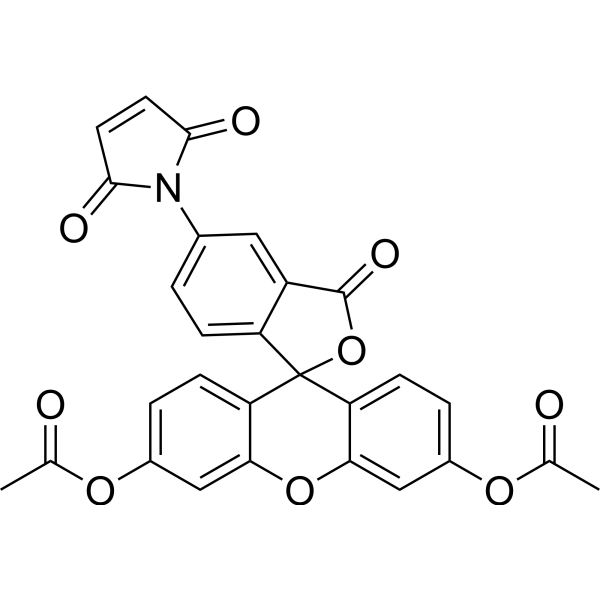
-
- HY-D0100
-
|
|
Fluorescent Dye
|
|
|
Fluorescein-diacetate-5-isothiocyanat is a colorimetric probe formed by the reaction of adipic acid dihydrazide and fluorescein isothiocyanate.
|
-
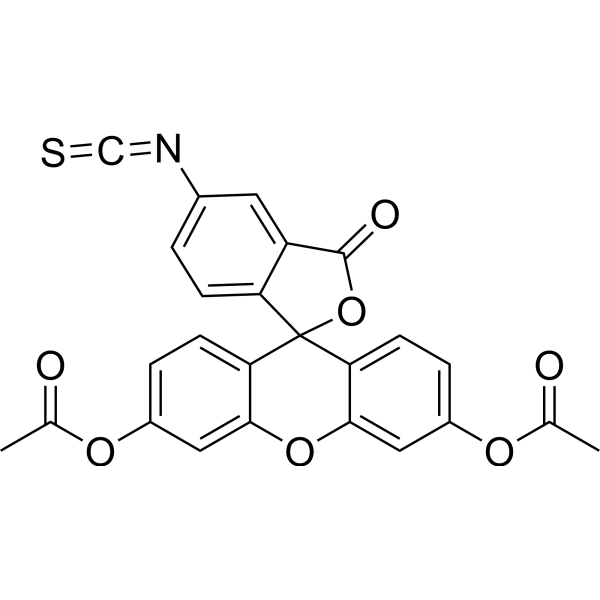
-
- HY-D2329
-
|
|
Fluorescent Dye
|
|
|
Fluorescein-PEG4-NHS ester is a colorimetric probe formed by the reaction of adipic acid dihydrazide and fluorescein isothiocyanate.
|
-

-
- HY-W009688
-
|
|
Others
|
Inflammation/Immunology
|
|
Dibutyl maleate, the diester of the Maleic Acid, can be used as an intermediate of pharmaceutical synthesis. Dibutyl maleate can enhance contact sensitization to Fluorescein isothiocyanate in mice .
|
-

-
- HY-151644
-
|
|
Fluorescent Dye
|
Others
|
|
Fluorescein hydrazide is a colorimetric probe formed by the reaction of dihydrazine adipate with fluorescein isothiocyanate. Fluorescein hydrazide can be used to label aldehyde and ketone groups .
|
-
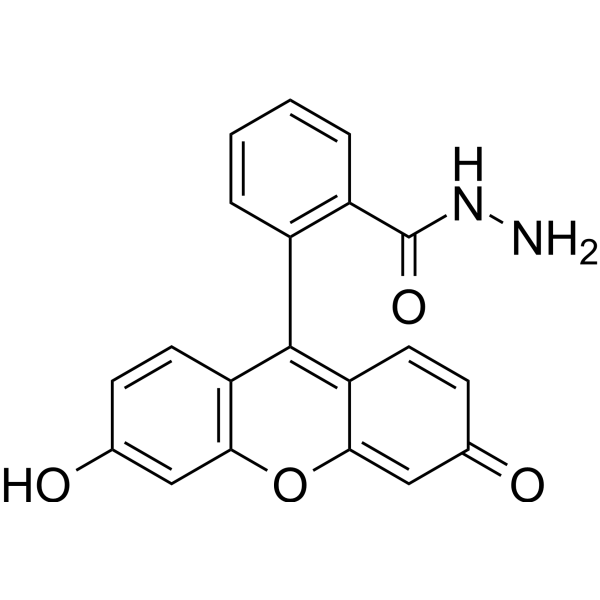
-
- HY-W110898
-
|
|
Fluorescent Dye
|
Others
|
|
Nile blue chloride is a highly fluorescent and photostable organic dye. Nile blue chloride and fluorescein isothiocyanate (FITC) can be used to construct a ratiometric pH sensitive probe for tracking the pH of the extracellular fluid between cancer cells in realtime. Nile Blue chloride has the potential for the research of nonlinear optics .
|
-

-
- HY-128868C
-
|
|
Biochemical Assay Reagents
|
Others
|
|
FITC-Dextran (MW 20000) is a compound belonging to the class of fluorescent dyes. It is commonly used in biomedical research as a tracer molecule to label and track cells or other biological matter. FITC-Dextran consists of fluorescein isothiocyanate (FITC) and dextran, a complex carbohydrate derived from starch. The combination of the two creates a stable fluorescent tracer that can be viewed under a microscope or quantified using specialized detection instruments.
|
-
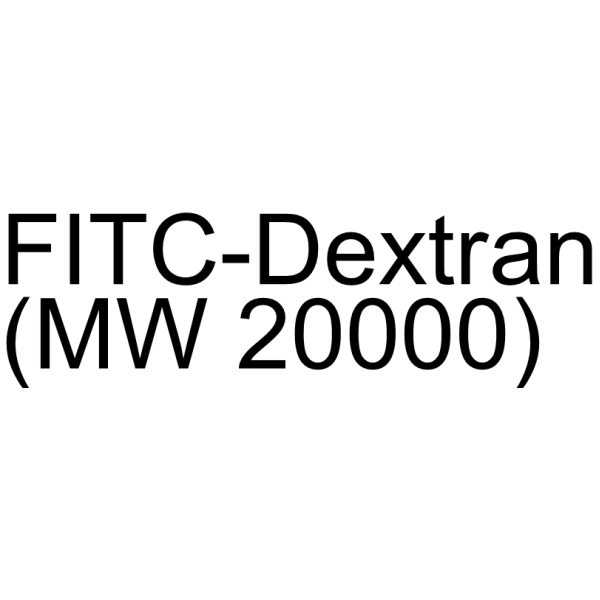
-
- HY-128868E
-
|
|
Biochemical Assay Reagents
|
Others
|
|
FITC-Dextran (MW 70000) is a compound belonging to the class of fluorescent dyes. It is commonly used in biomedical research as a tracer molecule to label and track cells or other biological matter. FITC-Dextran consists of fluorescein isothiocyanate (FITC) and dextran, a complex carbohydrate derived from starch. The combination of the two creates a stable fluorescent tracer that can be viewed under a microscope or quantified using specialized detection instruments.
|
-
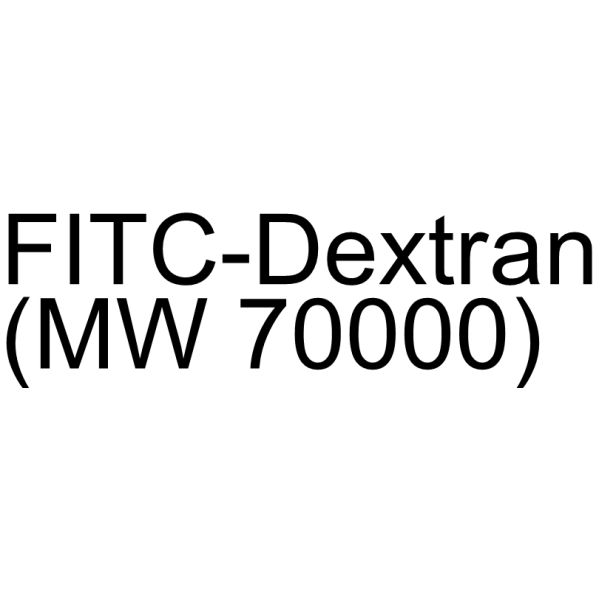
-
- HY-128868F
-
|
|
Biochemical Assay Reagents
|
Others
|
|
FITC-Dextran (MW 110000) is a compound belonging to the class of fluorescent dyes. It is commonly used in biomedical research as a tracer molecule to label and track cells or other biological matter. FITC-Dextran consists of fluorescein isothiocyanate (FITC) and dextran, a complex carbohydrate derived from starch. The combination of the two creates a stable fluorescent tracer that can be viewed under a microscope or quantified using specialized detection instruments.
|
-
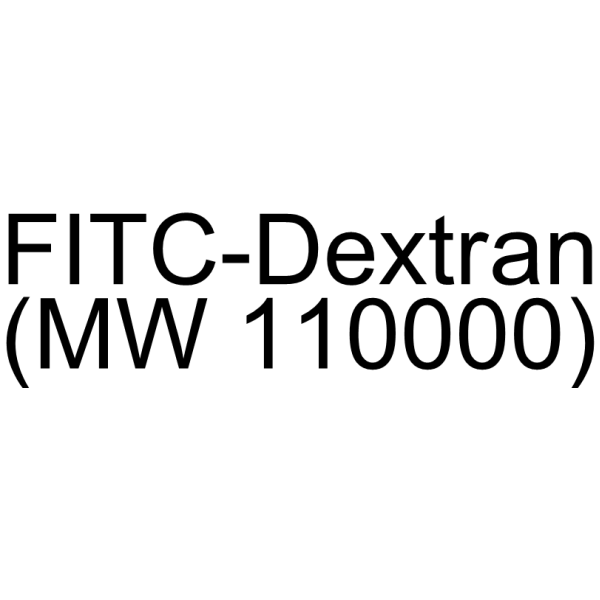
-
- HY-128868H
-
|
|
Biochemical Assay Reagents
|
Others
|
|
FITC-Dextran (MW 500000) is a compound belonging to the class of fluorescent dyes. It is commonly used in biomedical research as a tracer molecule to label and track cells or other biological matter. FITC-Dextran consists of fluorescein isothiocyanate (FITC) and dextran, a complex carbohydrate derived from starch. The combination of the two creates a stable fluorescent tracer that can be viewed under a microscope or quantified using specialized detection instruments.
|
-
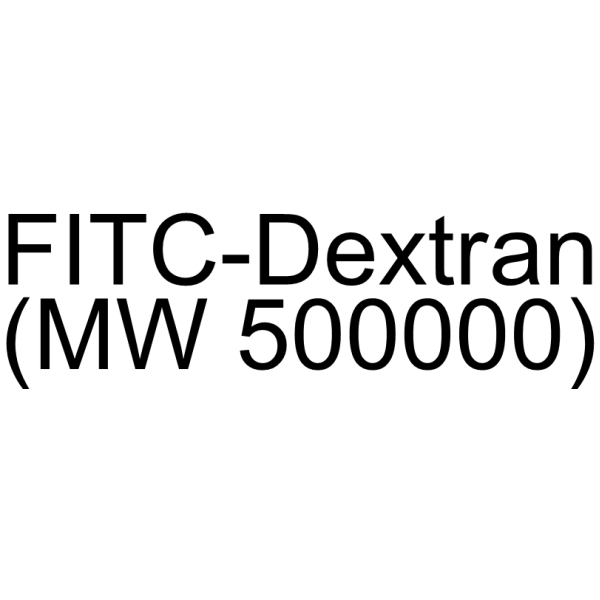
-
- HY-128868I
-
|
|
Biochemical Assay Reagents
|
Others
|
|
FITC-Dextran (MW 2000000) is a compound belonging to the class of fluorescent dyes. It is commonly used in biomedical research as a tracer molecule to label and track cells or other biological matter. FITC-Dextran consists of fluorescein isothiocyanate (FITC) and dextran, a complex carbohydrate derived from starch. The combination of the two creates a stable fluorescent tracer that can be viewed under a microscope or quantified using specialized detection instruments.
|
-

-
- HY-130851
-
|
|
HSP
|
Cancer
|
|
HS-27, a fluorescently-tethered Hsp90 inhibitor, assays surface Hsp90 expression on intact tissue specimens. HS-27 is made up of the core elements of SNX-5422, an Hsp90 inhibitor, tethered via a PEG linker to a fluorescein derivative (fluorescein isothiocyanate or FITC), that binds to ectopically expressed Hsp90. HS-27 has potential use in a see-and-treat paradigm in breast cancer .
|
-

-
- HY-128868B
-
|
|
Biochemical Assay Reagents
|
Others
|
|
FITC-Dextran (MW 3000-5000) is a fluorescent probe for fluorescein isothiocyanate (FITC) dextran (Ex=495 nm; Em=525 nm). FITC-Dextran (MW 3000-5000) can be used as a marker to reveal heat shock-induced cell damage and to study the early and late stages of apoptosis. FITC-Dextran (MW 3000-5000) can also be used for cell permeability studies, such as blood-brain barrier permeability and determination of the extent of blood-brain barrier disruption . Storage: protect from light.
|
-
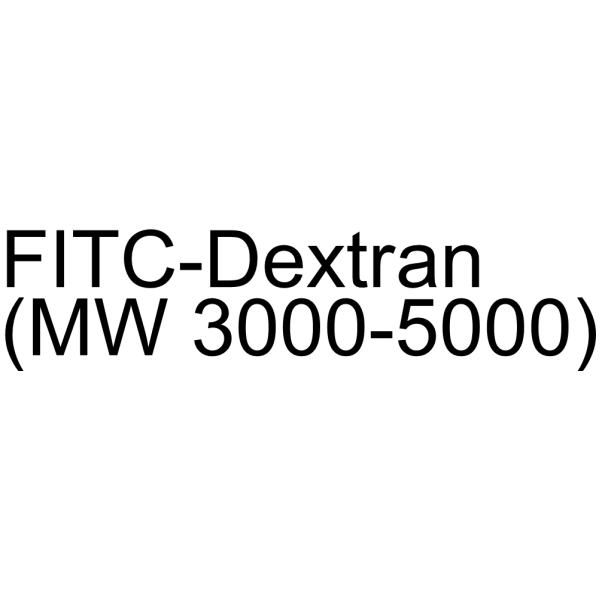
-
- HY-66019
-
FITC
Maximum Cited Publications
37 Publications Verification
fluorescein 5-isothiocyanate
|
Fluorescent Dye
|
Others
|
|
FITC (Fluorescein Isothiocyanate), is one of the green fluorescein derivatives widely used in biology. FITC has the characteristics of high absorptivity, excellent fluorescence quantum yield and good water solubility. The isothiocyanate group of FITC can be combined with amino, sulfhydryl, imidazole, tyrosyl, carbonyl and other groups on the protein, so as to achieve protein labeling including antibodies and lectins. In addition to its use as a protein marker, FITC can also be used as a fluorescent protein tracer to rapidly identify pathogens by labeling antibodies, or for microsequencing of proteins and peptides (HPLC). The maximum excitation wavelength of FITC is 494 nm. Once excited, it fluoresces yellow-green at a maximum emission wavelength of 520 nm.
|
-
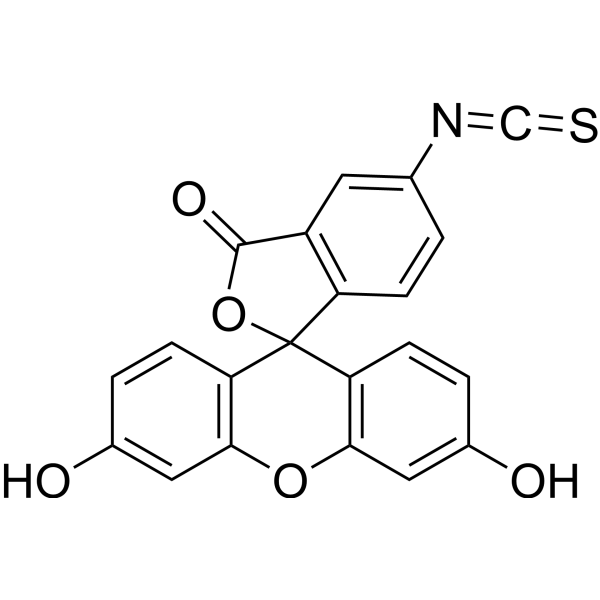
-
- HY-P2496
-
|
|
Endothelin Receptor
|
Cardiovascular Disease
|
|
Endothelin 1 (swine, human), Alexa Fluor 488-labeled is a synthetic Endothelin 1 peptide labled with Alexa Fluor 488. Endothelin 1 (swine, human) is a synthetic peptide with the sequence of human and swine Endothelin 1, which is a potent endogenous vasoconstrictor. Endothelin 1 acts through two types of receptors ETA and ETB .
|
-
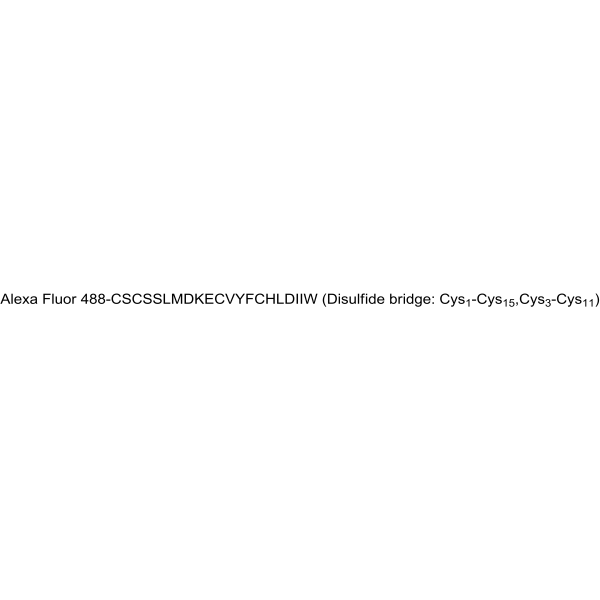
-
- HY-P4901
-
-
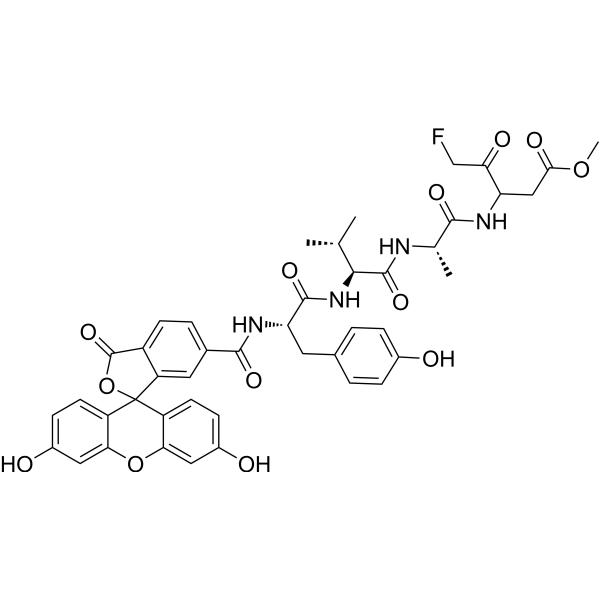
| Cat. No. |
Product Name |
Type |
-
- HY-15941
-
|
fluorescein 5(6)-isothiocyanate; fluorescein isothiocyanate 5- and 6- isomers
|
Fluorescent Dyes/Probes
|
|
5(6)-FITC (Fluorescein 5(6)-isothiocyanate) is an amine-reactive derivative of fluorescein dye that has wide-ranging applications as a label for antibodies and other probes, for use in fluorescence microscopy, flow cytometry and immunofluorescence-based assays such as Western blotting and ELISA.
|
-
- HY-66020
-
6-FITC
1 Publications Verification
6-fluorescein isothiocyanate
|
Fluorescent Dyes/Probes
|
|
6-FITC (6-Fluorescein Isothiocyanate) is a derivative of fluorescein used in wide-ranging applications including flow cytometry.
|
-
- HY-128868
-
|
|
Fluorescent Dyes/Probes
|
|
FITC-Dextran (MW 10000) is a fluorescent probe for fluorescein isothiocyanate (FITC) dextran (Ex=495 nm; Em=525 nm). FITC-Dextran (MW 10000) can be used as a marker to reveal heat shock-induced cell damage and to study the early and late stages of apoptosis. FITC-Dextran (MW 10000) can also be used for cell permeability studies, such as blood-brain barrier permeability and determination of the extent of blood-brain barrier disruption .
|
-
- HY-128868A
-
|
|
Fluorescent Dyes/Probes
|
|
FITC-Dextran (MW 4000) is a fluorescent probe for fluorescein isothiocyanate (FITC) dextran (Ex=495 nm; Em=525 nm). FITC-Dextran (MW 4000) can be used as a marker to reveal heat shock-induced cell damage and to study the early and late stages of apoptosis. FITC-Dextran (MW 4000) can also be used for cell permeability studies, such as blood-brain barrier permeability and determination of the extent of blood-brain barrier disruption .
|
-
- HY-128868D
-
|
|
Fluorescent Dyes/Probes
|
|
FITC-Dextran (MW 40000) is a fluorescent probe for fluorescein isothiocyanate (FITC) dextran (Ex=495 nm; Em=525 nm). FITC-Dextran (MW 40000) can be used as a marker to reveal heat shock-induced cell damage and to study the early and late stages of apoptosis. FITC-Dextran (MW 40000) can also be used for cell permeability studies, such as blood-brain barrier permeability and determination of the extent of blood-brain barrier disruption .
|
-
- HY-128868G
-
|
|
Fluorescent Dyes/Probes
|
|
FITC-Dextran (MW 150000) is a fluorescent probe for fluorescein isothiocyanate (FITC) dextran (Ex=491 nm; Em=518 nm). FITC-Dextran (MW 150000) can be used as a marker to reveal heat shock-induced cell damage and to study the early and late stages of apoptosis. FITC-Dextran (MW 150000) can be used in perfusion studies in animals or in fluorescence microlymphography, to study processes that affect the permeability of the blood brain barrier (BBB) . FITC-Dextran (MW 150000) can be used as fluorescent probe to study cell permeability .
|
-
- HY-D0108
-
|
|
Fluorescent Dyes/Probes
|
|
Fluorescein dilaurate is a colorimetric probe formed by the reaction of adipic acid dihydrazide and fluorescein isothiocyanate.
|
-
- HY-D0107
-
|
|
Fluorescent Dyes/Probes
|
|
Fluorescein dicaproate is a colorimetric probe formed by the reaction of adipic acid dihydrazide and fluorescein isothiocyanate.
|
-
- HY-D0101
-
|
|
Dyes
|
|
Fluorescein-diphosphat (diammonium) is a colorimetric probe formed by the reaction of adipic acid dihydrazide and fluorescein isothiocyanate.
|
-
- HY-D0105
-
|
|
Dyes
|
|
Fluorescein diacetate 6-isothiocyanate is a colorimetric probe formed by the reaction of adipic acid dihydrazide and fluorescein isothiocyanate.
|
-
- HY-D0103
-
|
|
Fluorescent Dyes/Probes
|
|
Fluorescein diacetate 5-maleimide is a colorimetric probe formed by the reaction of adipic acid dihydrazide and fluorescein isothiocyanate.
|
-
- HY-D0100
-
|
|
Fluorescent Dyes/Probes
|
|
Fluorescein-diacetate-5-isothiocyanat is a colorimetric probe formed by the reaction of adipic acid dihydrazide and fluorescein isothiocyanate.
|
-
- HY-D2329
-
|
|
Fluorescent Dyes/Probes
|
|
Fluorescein-PEG4-NHS ester is a colorimetric probe formed by the reaction of adipic acid dihydrazide and fluorescein isothiocyanate.
|
-
- HY-151644
-
|
|
Fluorescent Dyes/Probes
|
|
Fluorescein hydrazide is a colorimetric probe formed by the reaction of dihydrazine adipate with fluorescein isothiocyanate. Fluorescein hydrazide can be used to label aldehyde and ketone groups .
|
-
- HY-128868C
-
|
|
Dyes
|
|
FITC-Dextran (MW 20000) is a compound belonging to the class of fluorescent dyes. It is commonly used in biomedical research as a tracer molecule to label and track cells or other biological matter. FITC-Dextran consists of fluorescein isothiocyanate (FITC) and dextran, a complex carbohydrate derived from starch. The combination of the two creates a stable fluorescent tracer that can be viewed under a microscope or quantified using specialized detection instruments.
|
-
- HY-128868E
-
|
|
Dyes
|
|
FITC-Dextran (MW 70000) is a compound belonging to the class of fluorescent dyes. It is commonly used in biomedical research as a tracer molecule to label and track cells or other biological matter. FITC-Dextran consists of fluorescein isothiocyanate (FITC) and dextran, a complex carbohydrate derived from starch. The combination of the two creates a stable fluorescent tracer that can be viewed under a microscope or quantified using specialized detection instruments.
|
-
- HY-128868F
-
|
|
Dyes
|
|
FITC-Dextran (MW 110000) is a compound belonging to the class of fluorescent dyes. It is commonly used in biomedical research as a tracer molecule to label and track cells or other biological matter. FITC-Dextran consists of fluorescein isothiocyanate (FITC) and dextran, a complex carbohydrate derived from starch. The combination of the two creates a stable fluorescent tracer that can be viewed under a microscope or quantified using specialized detection instruments.
|
-
- HY-128868H
-
|
|
Dyes
|
|
FITC-Dextran (MW 500000) is a compound belonging to the class of fluorescent dyes. It is commonly used in biomedical research as a tracer molecule to label and track cells or other biological matter. FITC-Dextran consists of fluorescein isothiocyanate (FITC) and dextran, a complex carbohydrate derived from starch. The combination of the two creates a stable fluorescent tracer that can be viewed under a microscope or quantified using specialized detection instruments.
|
-
- HY-128868I
-
|
|
Dyes
|
|
FITC-Dextran (MW 2000000) is a compound belonging to the class of fluorescent dyes. It is commonly used in biomedical research as a tracer molecule to label and track cells or other biological matter. FITC-Dextran consists of fluorescein isothiocyanate (FITC) and dextran, a complex carbohydrate derived from starch. The combination of the two creates a stable fluorescent tracer that can be viewed under a microscope or quantified using specialized detection instruments.
|
-
- HY-128868B
-
|
|
Dyes
|
|
FITC-Dextran (MW 3000-5000) is a fluorescent probe for fluorescein isothiocyanate (FITC) dextran (Ex=495 nm; Em=525 nm). FITC-Dextran (MW 3000-5000) can be used as a marker to reveal heat shock-induced cell damage and to study the early and late stages of apoptosis. FITC-Dextran (MW 3000-5000) can also be used for cell permeability studies, such as blood-brain barrier permeability and determination of the extent of blood-brain barrier disruption . Storage: protect from light.
|
-
- HY-66019
-
FITC
Maximum Cited Publications
37 Publications Verification
fluorescein 5-isothiocyanate
|
Fluorescent Dyes/Probes
|
|
FITC (Fluorescein Isothiocyanate), is one of the green fluorescein derivatives widely used in biology. FITC has the characteristics of high absorptivity, excellent fluorescence quantum yield and good water solubility. The isothiocyanate group of FITC can be combined with amino, sulfhydryl, imidazole, tyrosyl, carbonyl and other groups on the protein, so as to achieve protein labeling including antibodies and lectins. In addition to its use as a protein marker, FITC can also be used as a fluorescent protein tracer to rapidly identify pathogens by labeling antibodies, or for microsequencing of proteins and peptides (HPLC). The maximum excitation wavelength of FITC is 494 nm. Once excited, it fluoresces yellow-green at a maximum emission wavelength of 520 nm.
|
| Cat. No. |
Product Name |
Target |
Research Area |
-
- HY-P2496
-
|
|
Endothelin Receptor
|
Cardiovascular Disease
|
|
Endothelin 1 (swine, human), Alexa Fluor 488-labeled is a synthetic Endothelin 1 peptide labled with Alexa Fluor 488. Endothelin 1 (swine, human) is a synthetic peptide with the sequence of human and swine Endothelin 1, which is a potent endogenous vasoconstrictor. Endothelin 1 acts through two types of receptors ETA and ETB .
|
-
- HY-P4901
-
| Cat. No. |
Product Name |
Category |
Target |
Chemical Structure |
Your information is safe with us. * Required Fields.
Inquiry Information
- Product Name:
- Cat. No.:
- Quantity:
- MCE Japan Authorized Agent:


































